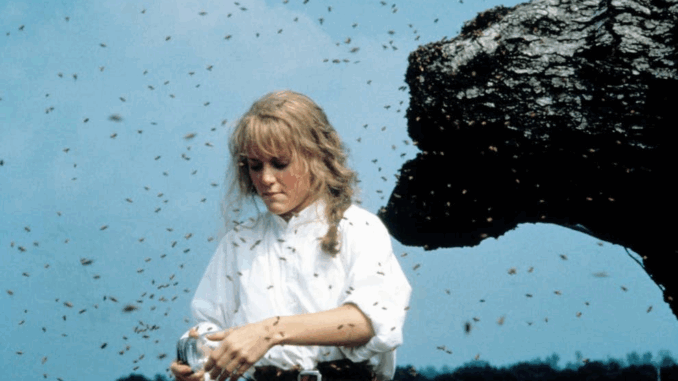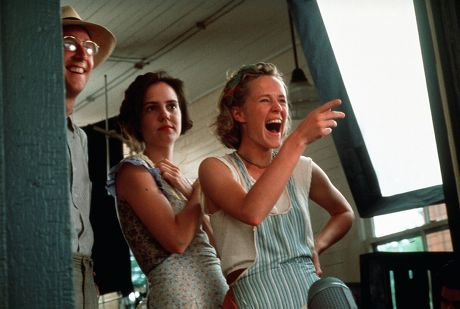
Fearless Among the Bees
Early in Fried Green Tomatoes, one of the most unforgettable scenes introduces us to a young Idgie Threadgoode in her most untamed, fearless form. In an attempt to impress Ruth Jamison—and perhaps to hide how much she’s already fallen for her—Idgie walks directly into the woods, approaches a live beehive nestled inside a hollow tree, and plunges her bare hand inside to retrieve a fresh chunk of honeycomb.
She returns triumphant, laughing, sticky, and stung, with honey dripping from her arm and pride radiating from her face. “See there?” she says. “The bees know I wouldn’t hurt them.”
The scene is light-hearted and humorous on the surface, but beneath that wild grin is one of the most richly symbolic moments in the film.
The Symbolism of the Bees
Bees have long held symbolic meaning across cultures: they represent community, structure, industry, and sometimes danger. In many traditions, they are protectors of sweetness—producers of something desirable but guarded.
Idgie’s relationship to the bees represents her relationship to society itself. She doesn’t see danger where others do. She isn’t afraid to take what she needs, even if it means getting hurt in the process. She trusts her instincts, lives outside the boundaries of polite behavior, and doesn’t flinch when nature pushes back.
By retrieving the honey, she proves something to Ruth—but also to herself: that courage is not the absence of fear, but the willingness to reach into something dangerous and emerge with something beautiful.
An Act of Courtship in Code

At its core, this scene is also an act of courtship. Idgie is showing off for Ruth, but not with jewelry or flowers. Instead, she offers something raw and natural, something rooted in the land around her. The honey becomes more than a gift—it is a declaration.
Ruth, demure and hesitant at this stage, watches with a mixture of horror and delight. She’s not used to women like Idgie. Most Southern ladies she knows would never approach a beehive, much less stick their hand into one. But Ruth is intrigued—not just by Idgie’s wildness, but by the way it feels free.
This offering of honey becomes the beginning of their bond. It is flirtation without words. A love letter written in nature.
Femininity Redefined
In contrast to Ruth’s genteel, religious upbringing, Idgie embodies an entirely different vision of womanhood. She dresses like a boy, fishes with her bare hands, speaks her mind, and walks away from church sermons. She is, by all societal standards of the time, improper.
The beehive scene crystallizes this defiance. It says: I am not who you expect me to be—and I’m not afraid to bleed for what I believe in.
But Idgie’s defiance isn’t empty rebellion. It’s a form of protection. The world hurt her when she lost her brother Buddy. She built her wildness as armor. But with Ruth, something begins to shift. The honey isn’t just for show—it’s the first gesture of vulnerability.
By offering something sweet, Idgie opens the door to intimacy.
Nature as Character
The Southern landscape in Fried Green Tomatoes is more than a backdrop—it’s a character in its own right. The trees, the river, the dusty roads, and, yes, the bees, all serve as mirrors to the inner lives of the characters. In this scene, nature is Idgie’s accomplice.
She moves through the woods like she belongs there. She isn’t invading the bees’ world; she’s part of it. The wilderness, in contrast to the stifling structures of the town, church, and courthouse, is where Idgie is free to be fully herself.
It’s no coincidence that many of her pivotal emotional scenes take place in nature. It is there, among the trees and creatures, that she can shed societal expectations and simply exist.
A Scene that Echoes Throughout the Film
Though the beehive scene happens early, its impact ripples throughout the film. It establishes Idgie as brave, yes, but also deeply connected to the land and to Ruth. That chunk of honey is a metaphor that recurs again and again: sometimes the sweetest things come at a cost. Sometimes love stings. But it’s worth it.
Later, when Ruth becomes ill and their time together grows shorter, the wildness of that early honey-fetching moment contrasts with the quiet tenderness of their domestic life. The café becomes their hive—buzzing with people, protected by loyalty, and built with care.
And by the time the story is retold to Evelyn by Ninny, the metaphor has fully bloomed. Evelyn, like Idgie, begins to reach for the sweetness hidden within a dangerous life. She, too, must risk the sting in order to reclaim her joy.
Legacy of the Scene
This moment has become one of the most iconic in the film, in part because of its visual boldness—Jessica Tandy’s narration, Mary Stuart Masterson’s defiant grin, the buzzing swarm, the glistening honey—but also because it defines the film’s tone.
It’s playful and serious. Wild and gentle. Feminine and feral.
The scene teaches that bravery isn’t loud. Sometimes, it’s reaching into the unknown and believing that you’ll be okay. That the bees won’t hurt you—because you mean them no harm. Or maybe they will hurt you, but you’ll survive anyway.
Idgie survives. Ruth softens. Evelyn awakens.
All because of a moment in the woods, with a beehive, and a girl who didn’t care about getting stung.
Conclusion: Sweetness in the Wild
The beehive scene in Fried Green Tomatoes is more than a moment of daring. It is a symbol of the film’s core themes—love, risk, rebellion, and the beauty of nonconformity. It marks the beginning of a lifelong bond between two women who defied expectations, and it shows that sometimes the sweetest things in life come from the wildest places.
Idgie’s hand in that hive is a hand reaching toward freedom.
And she never once flinched.
